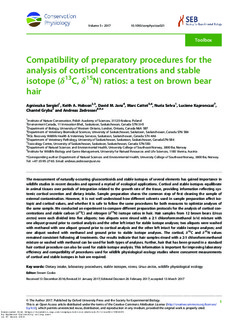| dc.contributor.author | Sergiel, Agnieszka | |
| dc.contributor.author | Hobson, Keith A. | |
| dc.contributor.author | Janz, David M. | |
| dc.contributor.author | Cattet, Marc | |
| dc.contributor.author | Selva, Nuria | |
| dc.contributor.author | Kapronczai, Luciene | |
| dc.contributor.author | Gryba, Chantel | |
| dc.contributor.author | Zedrosser, Andreas | |
| dc.date.accessioned | 2018-06-05T07:44:25Z | |
| dc.date.available | 2018-06-05T07:44:25Z | |
| dc.date.created | 2017-12-30T17:17:07Z | |
| dc.date.issued | 2017 | |
| dc.identifier.citation | Conservation Physiology. 2017, 5 (1), 1-7. | nb_NO |
| dc.identifier.issn | 2051-1434 | |
| dc.identifier.uri | http://hdl.handle.net/11250/2500250 | |
| dc.description.abstract | The measurement of naturally occurring glucocorticoids and stable isotopes of several elements has gained importance in wildlife studies in recent decades and opened a myriad of ecological applications. Cortisol and stable isotopes equilibrate in animal tissues over periods of integration related to the growth rate of the tissue, providing information reflecting systemic cortisol secretion and dietary intake. Sample preparation shares the common step of first cleaning the sample of external contamination. However, it is not well understood how different solvents used in sample preparation affect isotopic and cortisol values, and whether it is safe to follow the same procedures for both measures to optimize analyses of the same sample. We conducted an experiment to compare different preparation protocols for the analysis of cortisol concentrations and stable carbon (δ13C) and nitrogen (δ15N) isotope ratios in hair. Hair samples from 12 brown bears (Ursus arctos) were each divided into five aliquots; two aliquots were rinsed with a 2:1 chloroform:methanol (v/v) mixture with one aliquot ground prior to cortisol analysis and the other left intact for stable isotope analyses; two aliquots were washed with methanol with one aliquot ground prior to cortisol analysis and the other left intact for stable isotope analyses; and one aliquot washed with methanol and ground prior to stable isotope analyses. The cortisol, δ13C and δ15N values remained consistent following all treatments. Our results indicate that hair samples rinsed with a 2:1 chloroform:methanol mixture or washed with methanol can be used for both types of analyses. Further, hair that has been ground in a standard hair cortisol procedure can also be used for stable isotope analysis. This information is important for improving laboratory efficiency and compatibility of procedures used for wildlife physiological ecology studies where concurrent measurements of cortisol and stable isotopes in hair are required. | nb_NO |
| dc.language.iso | eng | nb_NO |
| dc.rights | Navngivelse 4.0 Internasjonal | * |
| dc.rights.uri | http://creativecommons.org/licenses/by/4.0/deed.no | * |
| dc.title | Compatibility of preparatory procedures for the analysis of cortisol concentrations and stable isotope (δ13C, δ15N) ratios: a test on brown bear hair | nb_NO |
| dc.type | Journal article | nb_NO |
| dc.type | Peer reviewed | nb_NO |
| dc.description.version | publishedVersion | nb_NO |
| dc.rights.holder | The Author, 2017 | nb_NO |
| dc.source.volume | 5 | nb_NO |
| dc.source.journal | Conservation Physiology | nb_NO |
| dc.source.issue | 1 | nb_NO |
| dc.identifier.doi | 10.1093/conphys/cox021 | |
| dc.identifier.cristin | 1533057 | |
| cristin.unitcode | 222,58,1,0 | |
| cristin.unitname | Institutt for natur, helse og miljø | |
| cristin.ispublished | true | |
| cristin.fulltext | original | |
| cristin.qualitycode | 1 | |

